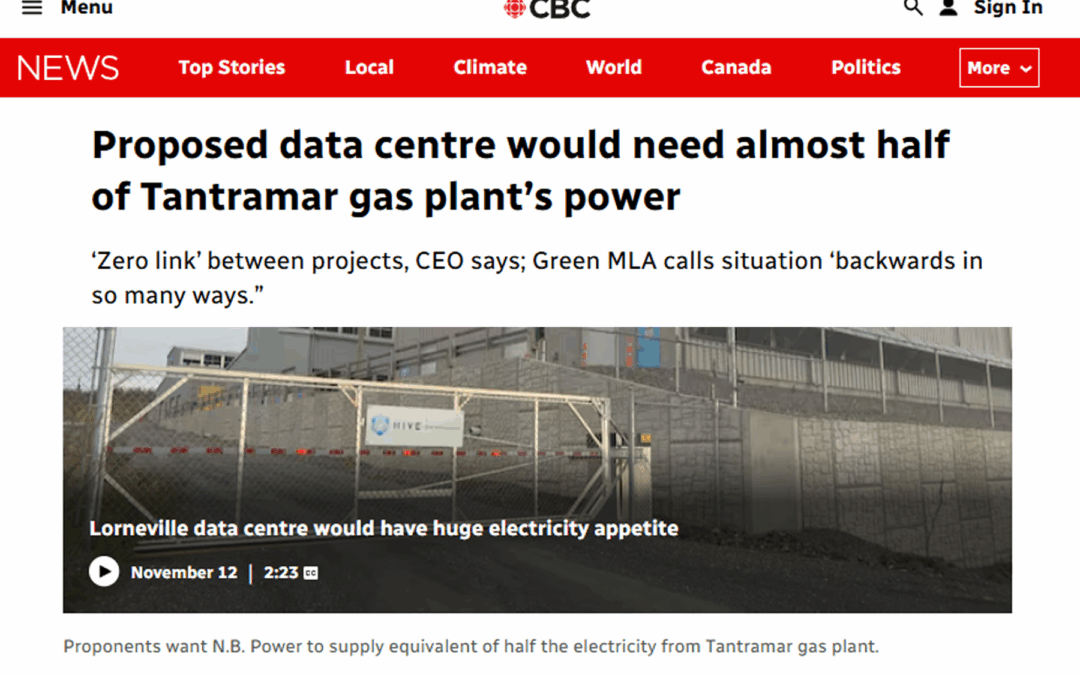TL;DR – The proposed Tantramar gas plant comes with serious health and climate risks. Residents would suffer the toll of fossil fuel emissions on their health, even if the plant runs intermittently—gas combustion produces nitrogen oxides and fine particulate matter, and the Lorneville data centre adds even more. This project is expensive, high-emission, and unnecessary when alternatives exist. Investing in renewables, energy efficiency, and storage can provide jobs and reliable electricity without locking communities into decades of harmful pollution.
The proposed Tantramar “peaker” gas plant has been promoted as a solution to keep the lights on and stabilize the grid. But the facts reveal a different story: this project is not about protecting the public, and it comes with serious health and climate risks.
Grid security? Not really.
Recent reporting by CBC shows that a proposed data centre in Lorneville, Saint John, could require almost half the electricity the Tantramar plant is meant to supply. The Volta Grid CEO projected a 380 MW load, with 190 MW drawn from NB Power. Green Party leader David Coon called the situation “backwards in so many ways,” highlighting the disconnect between the plant’s stated purpose and the industrial demand it would serve.
NB Power’s claim that the gas plant ensures grid reliability is misleading. Modern solutions—battery energy storage, demand-side flexibility, and interprovincial clean energy sharing—can handle peak demand without new high-emission fossil infrastructure that greatly impacts air quality. The plant’s “backup” role disappears once private, high-demand users are factored in. (CBC) (Wark Times)
Cost-effective? Hardly.
The Tantramar gas plant’s financial case collapses when half of its output is claimed by a private data centre before construction has even begun. While private actors profit, ratepayers will bear the cost and suffer the toll of fossil fuel emissions on health, air and water quality, and our natural environment.
NB Media Coop reports that renewables plus battery storage are far cheaper than new fossil gas—wind, for example, at approximately $47/MWh versus the gas plant’s projected $418/MWh. Building new fossil infrastructure now is a risky, expensive gamble that will lock New Brunswick into decades of pollution and high costs. (NB MediaCoop)
Capacity expansion: a hidden risk
Bid documents indicate that NB Power wants the Tantramar plant’s capacity to eventually double. The utility’s original request asked for companies to provide 400 MW, “with option to expand.” ProEnergy’s environmental impact assessment seeks approval for 10 gas-fired turbines generating up to 500 MW, while a letter of intent with the Tribal Council references an eventual total of 800 MW.
This massive scale far exceeds the needs of households and hospitals, highlighting the project’s focus on industrial and commercial demand. An 800 MW plant would produce significantly more emissions, increasing respiratory risks for nearby communities. Expansion plans magnify threats to public health while doing little to guarantee reliability for residents. (CBC)
“Cleaner” fossil fuel? Not for our lungs.
Even if the plant runs intermittently, gas combustion produces nitrogen oxides and fine particulate matter. Combined with the Lorneville data centre’s own gas generation, emissions would rise sharply, undermining New Brunswick’s modest climate gains and threatening public health. Respiratory illnesses—including asthma and COPD exacerbations—would increase in nearby communities.
Consultation and community concerns
Wark Times reporting shows Elsipogtog and other First Nations were not adequately consulted, despite claims to the contrary. Local residents have voiced strong opposition due to both health and environmental concerns. Environmental justice and public trust demand meaningful consultation and transparent decision-making—currently absent from the Tantramar project.
The bigger picture: fossil lock-in
According to the Canadian Centre for Policy Alternatives, the Atlantic provinces—including New Brunswick—remain heavily dependent on fossil fuel infrastructure. New projects like Tantramar further entrench the region in high-emission energy systems and increase the risk of stranded assets, while diverting investment from renewable alternatives. The report notes that “the window for viable development seems to be closing” for new fossil infrastructure in Eastern Canada. (CCPA PDF)
This is exactly the kind of fossil infrastructure the report warns against: expensive, high-emission, and unnecessary when alternatives exist. Investing in renewables, energy efficiency, and storage provides reliability without locking communities into decades of harmful pollution.
NB Lung’s position
- Public health first: Energy decisions must prioritize New Brunswickers’ lungs and well-being.
- Moratorium on new fossil infrastructure: We oppose projects that lock in emissions and expose communities to pollution.
- Full transparency and consultation: Communities and Indigenous Nations must have meaningful input, and all environmental and health impacts must be clearly disclosed.
Take Action
- Sign NB Lung’s advocacy letter opposing new fossil infrastructure in New Brunswick.
- Contact your MLA to demand a clean energy plan that protects public health and meets reliability without new fossil plants.
- Demand meaningful Indigenous consultation and release of all project-related documents.
Every New Brunswicker deserves clean air and honest answers — not a gas plant built to power private data farms.
Sources / Further Reading
Sign Our Letter Today
to help ensure the province follows through on its commitments to green energy infrastructure.

